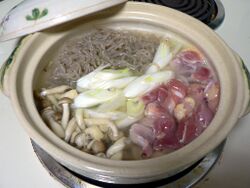Shirataki noodles
Topic: Chemistry
 From HandWiki - Reading time: 2 min
From HandWiki - Reading time: 2 min
 Shirataki noodles (top) and other ingredients in a donabe | |
| Type | Japanese noodles |
|---|---|
| Place of origin | Japan |
| Main ingredients | konjac |
Shirataki (Japanese: 白滝, often written with the hiragana しらたき) are translucent, gelatinous Japanese noodles made from the corm of the konjac plant. They are part of traditional Japanese cuisine, but they are also valuable to people with allergies or intolerances to wheat, gluten or eggs, or, for their low caloric value, to people restricting their energy intake by dieting.[1]
Composition
The konjac yam, whose corm (a thick underground stem) yields the yam-cake (konnyaku) from which the noodles are made, is also called devil's tongue yam or elephant yam. [2]:157-11 The word shirataki means "white waterfall", referring to the appearance of these noodles. Shirataki noodles are made from 97% water and 3% konjac, which contains glucomannan, a water-soluble dietary fiber. They are very low in digestible carbohydrates and food energy, and have little flavor of their own.[3][4][5]
Manufacture
There used to be a difference in manufacturing methods. Producers in the Kansai region of Japan prepared shirataki (called ito konnyaku there) by cutting konnyaku jelly into threads, while producers in the Kantō region made the noodles by extruding konnyaku sol through small holes into a hot, concentrated lime solution.[6] Modern producers make both types using the latter method.
Culinary use
Shirataki noodles come in dry and soft "wet" forms in Asian markets and some supermarkets. When purchased wet, they are packaged in liquid. They normally have a shelf life of up to one year. Some brands require rinsing and sautéing or parboiling, as the water in the packaging has an odor some find unpleasant.[7][8]
The noodles can also be drained and dry-roasted, which diminishes bitterness and gives the noodles a more pasta-like consistency. Dry-roasted noodles can be served in soup stock, sauce, or noodle soup.
Names and forms
Shirataki also goes by the names ito-konnyaku (Japanese: 糸こんにゃく), yam noodles, and devil's tongue noodles.[2]:157-12 The form called ito konnyaku is generally thicker than shirataki, with a square cross section and a darker color. It is preferred in the Kansai region.[citation needed]
References
- ↑ "Shirataki noodles: 6 health benefits, nutrition facts, and meals" (in en). 2021-05-20. https://www.medicalnewstoday.com/articles/shirataki-noodles.
- ↑ 2.0 2.1 Hui, Yiu. Handbook of food science, technology, and engineering. Volume 4. CRC Press: 2006.
- ↑ "Shirataki Noodle Recipes: The No-Carb Pasta". September 28, 2012. http://www.huffingtonpost.com/2012/09/28/shirataki-noodle-recipes_n_1919696.html.
- ↑ "Konjac Foods - Pure Fiber Zero Calories Pasta". http://www.konjacfoods.com/noodles/index.htm.
- ↑ "Why My Fridge Is Never Without Shirataki Noodles (and Yours Shouldn't be Either)". February 18, 2015. http://www.seriouseats.com/2015/02/how-to-cook-with-shirataki-noodles.html.
- ↑ (in Japanese) 「糸こんにゃく」と「しらたき」論争 , Tokyo Gas
- ↑ "Shirataki Noodles Are Hideous". 15 October 2014. https://www.huffpost.com/entry/shirataki-noodles-smell-a_b_5983830.
- ↑ "Wake up and smell the konjac". 3 March 2015. http://www.slimrice.co.uk/wake-up-and-smell-the-konjac/.
 |
 KSF
KSF